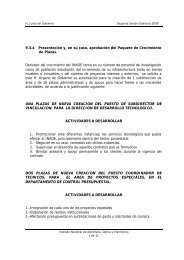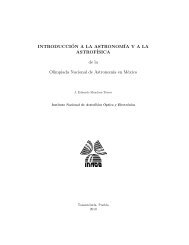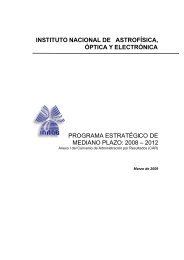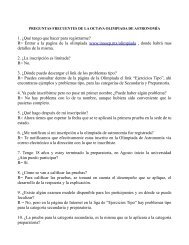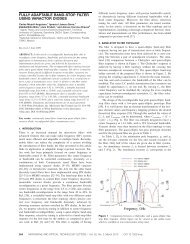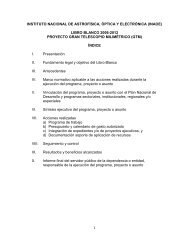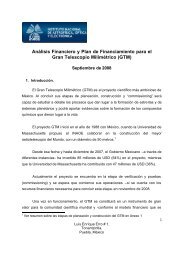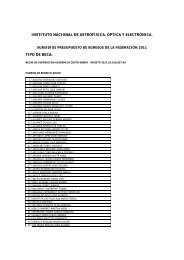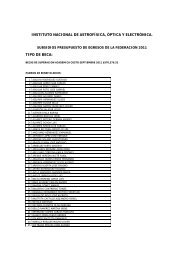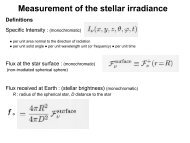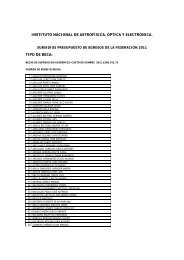Telescope Optical Design - inaoe
Telescope Optical Design - inaoe
Telescope Optical Design - inaoe
You also want an ePaper? Increase the reach of your titles
YUMPU automatically turns print PDFs into web optimized ePapers that Google loves.
Synoptic<br />
All-Sky<br />
Infrared<br />
Survey<br />
<strong>Telescope</strong> <strong>Optical</strong> <strong>Design</strong><br />
(preconcept issues)<br />
J. Jesús González (IA-UNAM)<br />
Guillermo Haro Workshop<br />
Aug 13-20 2008<br />
INAOE, Tonanzintla, Mexico
SASIR Proposal<br />
Survey, synoptically, the entire northern sky at infrared wavelengths to<br />
unprecedented depths (y, J, H & K)<br />
‣ Dedicated wide-field 6.5-meter telescope in SPM<br />
• 1 st Operation phase: 4-yr SASIR project<br />
• Afterwards: optical/NIR spectroscopic Survey, General Purpose telescope, etc<br />
Final 4-yr synoptic survey ~1,000 more sensitive than 2MASS covering a<br />
volume >30,000 times larger<br />
Enormous impact in the study of rare, faint, red and obscured objects<br />
in two domains:<br />
Time-resolved (synoptic) survey, unique in the IR<br />
Moving objects (local low-mass stars); Distance ladder (RR Lyrae, Cepheids, Miras),<br />
SNe surveys (Ia, II-N, PP) ; High-z transients (GRBs); Grav Wav & Neutrino<br />
missions counterparts ; Fast transients (orphan GRB afterglows?)<br />
Static Sky (single pointing & accumulated) survey<br />
Significantly deeper or wider than any ongoing or planed (≤4 m)
SASIR dedicated telescope<br />
A new large-telescope facility is needed for SASIR<br />
• 6-10m class telescopes (~8 VLTs per hemisphere):<br />
<br />
Each with a full site of traditional instrumentation<br />
The majority with relative narrow fields (< 20’)<br />
Optimal for faint or high-dispersion spectroscopy<br />
• 4m-class telescopes:<br />
Growing emphasis on large-scale programs and/or wide-field<br />
Vis&IR imagers: 2DF, SDSS, UKIDSS, VISTA, MOSA, ODI<br />
• 2m-class telescopes:<br />
Innovation is in fully automated, rapid-response systems,<br />
primarily for IR and optical imaging and spectroscopy<br />
A 6.5 m aperture: x2.6 step in NIR imaging (LSST comparable)
We do not start from scratch<br />
‣ SASIR builds up from Mexico’s developments and long<br />
term goals towards the optimal exploitation of the<br />
SPM virtues, in particular through a competitive worldclass<br />
optical/IR facility<br />
‣ INAOE & UA partnership for a polished primary<br />
mirror, schedule for casting this year<br />
‣ The Magellan telescopes are indeed an excellent<br />
reference for a proven efficient design<br />
• In particular the telescope and building, allowing us to<br />
concentrate on the new areas that need special attention or<br />
development (e.g. optimal optical design for the NIR)<br />
• Risks and unknown cost mitigated
SPM-Twin: Competitiveness based on optimized<br />
cost-effective concepts (Magellan/MMT)<br />
Large Grasp Concept:<br />
SPM-Twin large grasp (product of aperture, efficiency, multiplex advantage, field of view<br />
and pass-band) makes it possible to explore unique discovery spaces in the ELT era.<br />
Integrated <strong>Design</strong>:<br />
telescopes will be designed simultaneously with their major instrumentation, guaranteeing<br />
robust performance and minimization of overheads and compromises in each telescope.<br />
Risk mitigation:<br />
by exploiting these highly successful existing designs the SPM-Twin facility performance<br />
is guaranteed.<br />
Fast Schedule:<br />
focusing efforts mostly on the new developments required for the science programs, the<br />
schedule to build SPM-Twin should be relatively short (five to seven years).<br />
Economy:<br />
By maximally exploiting existing designs, non-recurring engineering costs are minimized.<br />
The integrated engineering approach will simplify operations once scientific observations<br />
commence, saving operations costs.
SPM-Twin: WF-Spectroscopic <strong>Telescope</strong><br />
Fields ≥ 1.5°<br />
with a Magellan-like 6.5 m<br />
telescope ?<br />
‣ Strategy and tools developed to<br />
design, compare and identify optical<br />
concepts<br />
‣ Minimal structural modifications<br />
‣ Viable optical elements<br />
‣ Integral system optimization<br />
• <strong>Telescope</strong> + WFC + ADC<br />
• Field Integration suitability<br />
• Spectral R & Δλ matching<br />
• Spectra packing, etc.
FWHM ["]<br />
FWHM ["]<br />
SPM-Twin:<br />
1.5°-2° fields with a Magellan-like 6.5 m ?<br />
…Yes !<br />
1.25<br />
1.25<br />
1<br />
0.75<br />
0.5<br />
0.25<br />
0.25<br />
0<br />
Wide-Field Optimization (6.5 m, f/4.5 telescopes)<br />
Wide-Field Optimization (6.5 m, f/4.5 telescopes)<br />
0 0.25 0.25 0.5 0.5 0.75 0.75 1<br />
FoV Radius [º]<br />
Bare <strong>Telescope</strong> (Ritchey-Chretien)<br />
Bare <strong>Telescope</strong> (Ritchey-Chretien)<br />
WF RC 0: 3-lens, T-fix, FP sphere<br />
WF RC 0: 3-lens, T-fix, FP sphere<br />
WF RC 1: 3-lens, T-fix, FP conic<br />
WF Bare WF RC <strong>Telescope</strong> 0: 3-lens, (Ritchey-Chretien)<br />
T-fix, FP sphere<br />
WF<br />
RC<br />
MT 2:<br />
1:<br />
3-lens,<br />
3-lens,<br />
T-opt,<br />
T-fix, FP<br />
FP<br />
conic<br />
sphere<br />
WF MT 2: 3: 3-lens, T-opt, FP sphere conic<br />
WF RC 1: 3-lens, T-fix, FP conic<br />
WF MT 4: 4-lens, T-opt, FP sphere<br />
WF WF RC MT 0: 3: 3-lens, 3-lens, T-fix, T-opt, FP FP sphere conic<br />
WF MT 5: 4-lens, T- opt, FP conic<br />
WF WF MT MT 2: 4: 3-lens, 4-lens, T-opt, FP FP sphere<br />
WF RC 4: 4-lens, T-fix, FP sphere<br />
WF MT RC 5: 4-lens, T-fix, opt, FP FP conic conic<br />
WF RC 1: 3-lens, T-fix, WF MT 3: 3-lens, T-opt, FP conic
SPM-Twin: WF <strong>Telescope</strong> focal ratios<br />
0<br />
-1<br />
Mirror Feasibility<br />
WFT Mirrors (Conic Constants and Sag)<br />
-2<br />
-3<br />
-4<br />
-5<br />
-6<br />
-7<br />
3.0 3.5 4.0 4.5 5.0 5.5 6.0<br />
<strong>Telescope</strong> f/#<br />
M1 Conic M1 Sag - Parabolid [mm] M2 Conic<br />
<br />
<br />
<br />
Non-parabolic<br />
Primary (M1)<br />
Glass to remove<br />
Secondary figuring
Diameter [mm]<br />
SPM-Twin: WF <strong>Telescope</strong> focal ratios (II)<br />
0.20<br />
0.18<br />
0.16<br />
0.14<br />
0.12<br />
0.10<br />
0.08<br />
0.06<br />
WFT Plate-scale & Effective Area<br />
3.0 3.5 4.0 4.5 5.0 5.5 6.0<br />
<strong>Telescope</strong> f/#<br />
mm/arc-sec<br />
Eff. Area lost<br />
Focal plane should<br />
couple naturally to fiber<br />
scale and NA demands<br />
3000<br />
WFT Optics Size<br />
2500<br />
2000<br />
1500<br />
1000<br />
M2 Cass<br />
M2 Nas<br />
1st WFC Lens<br />
Focal Surface<br />
Dimensions of secondary<br />
and corrector optics<br />
may be limiting factors<br />
500<br />
3.0 3.5 4.0 4.5 5.0 5.5 6.0<br />
<strong>Telescope</strong> f/#
SPM-Twin: WF <strong>Telescope</strong> focal ratios (III)<br />
90% PSF ["]<br />
FWHM ["]<br />
0.5<br />
WFT Image Quality (<strong>Telescope</strong> PSF)<br />
0.4<br />
0.3<br />
0.2<br />
1.5° Field<br />
1.0° Field<br />
0.5° Field<br />
0.1<br />
3.0 3.5 4.0 4.5 5.0 5.5 6.0<br />
<strong>Telescope</strong> f/#<br />
1.0<br />
WFT Image Diameters (Sky sampling)<br />
IF Spectroscopy:<br />
PSF extent is relevant<br />
(not just FWHM)<br />
0.8<br />
0.6<br />
0.4<br />
2.0° Field<br />
1.5° Field<br />
1.0° Field<br />
0.5° Field<br />
0.2<br />
3.0 3.5 4.0 4.5 5.0 5.5 6.0<br />
<strong>Telescope</strong> f/#
SPM-Twin: WFT Atmospheric Dispersion Correction<br />
Performance (Z=60° over 1.5° field of view)<br />
Circles:<br />
2” aperture<br />
(Spaxel)
SPM-TWIN WFT 1.5° Corrector<br />
1”<br />
Central<br />
spaxel<br />
WF+ADC<br />
Performance<br />
(Z=60°)<br />
1”<br />
@ 1.5° FoV<br />
spaxel<br />
MMT & Magellan 1° FoV (Fabricant et al, 2003)
100 cm<br />
S P M 6.5m f/4.5 WFT<br />
Effective aperture: 6.2 m<br />
M1 to M2: 6.02 m<br />
Plate scale 0.142 mm/arcsec<br />
P rim ary m irror<br />
Conic = -1.07198<br />
Curv. radius = 16,255 mm<br />
Hole diameter ≥ 1,100mm<br />
Se con dary mirror<br />
Conic = -3.78412<br />
Curv. radius = 5,813 mm<br />
Diameter: 1.9 - 2m (1.°5 - 2° fields)<br />
WF+ADC Fie ld<br />
3 silica lenses<br />
(all-spherical surfaces)<br />
ADC: 2 double prisms<br />
Largest lens (Silica meniscus)<br />
Aperture: 1.03 m (1.°5 field)<br />
1.25 m (2° field)<br />
Thickness: 75 to100 mm<br />
Curv. radii: 1.5 m & 4.0m (front, back)<br />
WFC Lenses: 3 Silica (all spheres)<br />
80 cm<br />
ADC Double prisms: 2 (K10 + N-Pk52A)
Nevertheless, a lot is different for SASIR<br />
‣ Near Infrared instead of a visible wide-field system<br />
‣ Thermal emission becomes quite relevant in K<br />
• Large cryogenics<br />
• White pupil and/or elaborated baffling<br />
• Heat transfer, emissivity & temperature gradients<br />
‣ Significantly better image quality<br />
‣ Limited availability of optical materials (CaF 2 , BaF 2 , etc)<br />
‣ Pixel scale calls for a faster system (~f/2.5)<br />
‣ Need to divide the field or to split the beam in 4<br />
‣ What is simpler?<br />
• No need for ADC<br />
• Some freedom on back focal & focal station<br />
• May consider other kind of telescope systems
Infrared emission<br />
Mauna Kea atmospheric transmission compared to the emissivity of a 2% emissive telescope for 2-<br />
mm of water vapour. Note how a mid-IR instrument is limited by the telescope emisivity over a<br />
significant part of the 10 micron window. Image: University of Florida Astronomy Group.<br />
Diciembre 27, 2007<br />
Astronomía Observacional IA-UNAM<br />
• Relative contributions of background light from<br />
the sky (green line) and a perfect telescope (red<br />
line), assuming 2-mm of water vapour and a<br />
telescope 98% reflectivity (an optical telescope<br />
may not pass 80% unless it has recently been<br />
cleaned and 95% is very difficult to attain). By<br />
making the optics as clean and reflective as<br />
possible (telescope mirrors and mirrors inside<br />
CanariCam) the radiation from the atmosphere<br />
can be the deciding factor in many cases, but in<br />
the best parts of the 10-micron window what<br />
limits us is the optical path.<br />
• <strong>Telescope</strong> contribution minimized by making the<br />
structure as light as possible (to "see" minimum of<br />
support structure) and by taking measures to<br />
maintain the mirrors very clean, including segment<br />
removal from the GTC every week to clean them<br />
on a cyclical basis (every six months approx the<br />
entire mirror surface is renewed). Giving the<br />
telescope a gold-coated secondary mirror may<br />
make another improvement in the future, as gold<br />
reflects infrared light very efficiently - much<br />
more so than aluminium or silver. These factors<br />
are beyond the control of CanariCam.<br />
• CanariCam Gold mirrors, each 99% reflective for<br />
infrared light are used. The detector and mirrors<br />
are cooled to below 30K (-245ºC) and a special<br />
shield (a light baffle) cooled to the same<br />
temperature blocks out all light that does not<br />
come from the telescope mirror.<br />
• We can also improve the instrument's sensitivity<br />
significantly by observing in cold and very dry<br />
conditions to reduce the background still further.<br />
By scheduling the most critical observations in<br />
queue observing mode we can take advantage of<br />
the very best conditions in the observatory,<br />
whenever they happen.
Infrared emission<br />
Effective Y, J, K, Hs SASIR throughput<br />
Mauna Kea atmospheric transmission compared to the emissivity of a 2% emissive telescope for 2-<br />
mm of water vapour. Note how a mid-IR instrument is limited by the telescope emisivity over a<br />
significant part of the 10 micron window. Image: University of Florida Astronomy Group.<br />
Diciembre 27, 2007<br />
Astronomía Observacional IA-UNAM
SASIR pre-conceptual design<br />
Tels explored:<br />
f/3.0 – f/9.0<br />
D2: 2.6 – 1.15 m<br />
Rc2: 10.1 - 2.8 m<br />
C2: -8.7 to -1.82<br />
C1: -1.2 to -1.01<br />
WFC:<br />
D1: 850 – 917mm<br />
R1: 1.67 – 1.18 m<br />
Collimator:<br />
D = 515 – 1148 mm<br />
F = 600 – 1800 mm<br />
Camera (F=500 mm)<br />
D = 457 – 426 mm
f/5.5 Classic & Gregorian systems<br />
M2 becomes too large at f/# < ~8
Normal Field<br />
9’ FoV (0.075)
Wide-field<br />
0.8 FoV
WFCAM (UKIDSS)<br />
‣ 3.8 m UK InfraRed <strong>Telescope</strong><br />
‣ Started operations in May 2005<br />
‣ Built by the ATC (Edinburgh)<br />
‣ 4 2048 2 Rockwell detectors (0.4”/pixel)<br />
‣ 0.21 square degree/exposure<br />
‣ ZYJHK filters<br />
‣ Data release 3 (2007)
Schmidt like solution
f/2.5
VISTA Infrared Camera<br />
‣ VISTA 4.1 m telescope<br />
‣ 1.65 degrees FoV, f/3.25<br />
‣ 16 Raytheon VIRGO 2048 2 HgCdTe<br />
‣ 0.34”/pixel, FoV=0.6 sq.deg/ex<br />
‣ Being commissioned
Relevant issues to cover by the optical<br />
conceptual design study<br />
‣ Best pixel scale (0.2”-0.35”)<br />
‣ Best pixel size (10-22μm)<br />
‣ Definitive conclusions of field vs. beam spliting<br />
‣ Base optical design (2-3 mirror, WFC, focal<br />
station, etc). M1 conic constant<br />
‣ Collimator & Camera concepts<br />
‣ Impact to telescope structure and building<br />
‣ Post-survey phases of the facility<br />
‣ Integral error-budget (telescope, optics, site<br />
conditions & operations) for optical design<br />
‣ Precise cryogenic indices of refraction
Conclusions<br />
‣ A 6.5m high-image quality wide-field NIR imaging telescope is quite<br />
feasible under a range of design configurations<br />
‣ A WF-corrected classical system looks particularly attractive, given<br />
its fewer uncertainties and its natural compatibility with the<br />
telescope structure and with 2 nd phase operations (integral field<br />
spectroscopy, general purpose telescope, etc.)<br />
‣ The main challenge is to be able to accommodate up to four focal<br />
planes under reasonable design, physical and performance<br />
constrains<br />
‣ Proposal Phase funding seek this year: will finance the conceptual<br />
design, we must then continue working hard to summarize the main<br />
science requirements while gauging realistic technical constrains
Thanks!
Feedback from the community<br />
‣ SASIR survey(s) definitions<br />
‣ Synergies with present & future facilities<br />
‣ MexCal broader collaborations<br />
‣ Required and potential follow-up projects &<br />
collaborations<br />
‣ Long-term plans for the facility
‣ Input from the community (diversity & interests)<br />
• What SASIR should do for your science ?<br />
• How the present sketch of SASIR science should change/mature<br />
• Brainstorm of ideas and concerns<br />
‣ Involvement areas<br />
• Surveys definition<br />
• Data products exploitation<br />
• Follow-up & parallel science<br />
‣ List of specific requirements from specific science cases<br />
‣ Synergies & complementary projects<br />
‣ Extend access/exchange with other facilities<br />
‣ Science for 2nd phase and beyond<br />
• General purpose telescope? some degree of specialization?<br />
• Other kind of NIR survey<br />
• WF optical/NIR spectroscopic survey<br />
‣ Workgroups for specific milestones
Some relevant milestones<br />
‣ US/Mex proposals to fund the design<br />
phase (NSF, CONACyT<br />
• NNN<br />
• Formalization of an specific CONACyT “red”<br />
‣ M1 Casting
Resolving power<br />
SPM-Twin: Wide-Field Sampling & Integration<br />
(complementary limitations)<br />
1.5° Field of View (5400”) = 1.77 square degrees<br />
Lots of sampling elements (“spaxels”): 2.4x10 7 squared arcsecs<br />
a) Full wavelength range with well-chosen spatial<br />
coverage (d-IFUs, fiber-bundles, starbugs)<br />
b) Full spatial coverage with a finite wavelength<br />
range (WFT tunable imager)<br />
1800<br />
OSIRIS TF: Available resolving powers<br />
1600<br />
1400<br />
1200<br />
1000<br />
800<br />
600<br />
400<br />
200<br />
0<br />
400 500 600 700 800 900 1000<br />
Wavelength (nm)<br />
m = 2 l cos <br />
R = m N<br />
dR/R = dm/m = dl/l<br />
R: 100 - 1000<br />
m: 4 – 40<br />
l : 1.5 – 15 μm<br />
K.A.O.S. Purple Book 2002<br />
GTC-OSIRIS
SPM-Twin WFT:<br />
3 Spaxel Distributions for Spectroscopy<br />
High-Z & Stellar objects<br />
a. Super sloan-like surveys (DE, LSS, etc. basically redshifts)<br />
b. Stellar surveys (thick disk, Local group systems)<br />
c. GC & PN systems<br />
d. HII Regions in local galaxies<br />
Very large number of individual spaxels (sparse sampling) with limited patrol<br />
fields each)<br />
The Intermediate-z Universe and semi-crowded fields<br />
a. Indicative galaxy dynamics, gradients and size<br />
b. Indicative structure (notches, pair interaction, etc)<br />
A number of relatively small IFUs (sparse with limited-continuous sampling),<br />
relatively large patrol fields<br />
The “local” 150 Mpc Universe<br />
a. Large galaxies<br />
b. galactic extended sources<br />
Single Large IFU (continuous sampling), fixed patrol field
Sitios privilegiados para el visible y el Infrarrojo<br />
Norte de Chile<br />
Islas de Hawai<br />
Islas Canarias<br />
San Pedro Mártir<br />
Antu<br />
Kueyen<br />
Melipal<br />
Yepun<br />
Gemini<br />
8.2m Europa<br />
8.2 Europa<br />
8.2 Europa<br />
8.2 Europa<br />
8.1 USA UK<br />
Canadá Brasil Chile<br />
Australia Argentina<br />
6.5 USA<br />
6.5 USA<br />
4.1 Brasil USA<br />
Baade<br />
Clay<br />
Soar<br />
Blanco 4.0 USA 74<br />
“360” 3.6 Europa 77<br />
NTech 3.5 Europa<br />
Keck I<br />
Keck II<br />
Subaru<br />
Gillet<br />
10m USA<br />
10 USA<br />
8.3 Japón<br />
8.1 USA UK<br />
Canadá Brasil Chile<br />
Australia Argentina<br />
UKIRT 3.8 UK 79<br />
Canadá, Holanda<br />
AEO 3.7 USA-AF<br />
CFHT 3.6 Canadá<br />
Francia USA 79<br />
IRTF 3.0 USA<br />
UH 2.2 USA 70<br />
GTC<br />
Herschel<br />
Galileo<br />
Newton<br />
Nordic<br />
Liverpool<br />
10.4m España<br />
México<br />
USA<br />
4.2 UK España<br />
Holanda<br />
3.6 Italia<br />
España<br />
2.5 UK España<br />
Holanda<br />
2.5 Dinamrca<br />
Islandia<br />
Noruega<br />
Finlandia<br />
Suecia<br />
2.0 Universitario<br />
SPM 2.1m México 79<br />
SPM 1.5 México<br />
SPM 0.8 México<br />
duPont 2.5 USA 75<br />
MPG-E 2.2 Europa<br />
Construcción: 1,200 M$<br />
Operación: 71 M$/año<br />
Construcción: 1,000 M$<br />
Operación: 76 M$/año<br />
Construcción: 300 M$<br />
Operación: 15 M$/año<br />
Construcción: 5 M$<br />
Operación: 1.0 M$/año<br />
Inversión de Construcción: sólo considera los telescopios (y edificio) listados sin sus instrumentos.<br />
Presupuesto de Operación (reportes anuales oficiales 2006): telescopios para Visible e Infrarrojo únicamente.<br />
Se excluyen radio, solar, altas energías, etc. así cómo presupuestos y desarrollos fuera del observatorio en centros de administración,<br />
investigación o del consorcio o de socios
Otros Telescopios (visible e infrarrojo)<br />
En EEUU continental<br />
HET 9.2 USA Alemania<br />
LBT<br />
2x8.4 USA Italia<br />
Alemania<br />
6.5 USA<br />
MMT<br />
Hale 5.0 USA 48<br />
Mayall 3.4 USA 73<br />
ARC 3.5 USA<br />
WIYN 3.5 USA<br />
Starfire<br />
Shane 3.0 USA 59<br />
H. Smith 2.7 USA 68<br />
Hooker 2.5 USA 17<br />
SLOAN<br />
3.5 USA Militar<br />
2.5 USA Europa<br />
Japón<br />
2.4 USA Francia<br />
CHARA<br />
MRO 2.4 USA<br />
Hiltner 2.4 USA<br />
WIRO 2.3 USA<br />
Bok 2.3 USA 69<br />
KP2.1 2.1 USA 61<br />
Struve 2.1 USA 69<br />
Construcción: ~800 M$<br />
Operación: ~60 M$/año<br />
En sitios diversos<br />
SALT<br />
9.8 Sudáfrica UK USA<br />
Alemania Polonia<br />
N. Zelanda<br />
Bolshoi 6.0 Rusia 76<br />
LZT<br />
6.0 Canadá USA<br />
Francia<br />
4.2 China USA<br />
LAMOST<br />
AAT 3.9 Australia UK 75<br />
MPIA<br />
3.5 Alemania<br />
España<br />
ByAO 2.6 Armenia 76<br />
Shajn 2.6 Ucrania 76<br />
duPont 2.4 Francia<br />
Lijiang 2.4 China<br />
ANU 2.3 Australia<br />
V. Bappu 2.3 India<br />
MPIA<br />
2.2 Alemania<br />
España<br />
2.2 China<br />
Beijing<br />
Sahade<br />
HCT 2.1 India<br />
Lyot 2.0 Francia<br />
Faulkes-S 2.0 Australia<br />
2.2 Argentina<br />
Construcción: ~310 M$<br />
Operación: ~40 M$/año<br />
En construcción<br />
VLT-Int 4 + x8.4m Europa (en Chile)<br />
Keck-Int 2x10 USA (en Hawai)<br />
LSST 8.0 USA (en Chile)<br />
Lamost 6.4 China USA UK<br />
DCT 4.2 USA (en USA)<br />
VISTA 4.0 Europa (en Chile)<br />
VST 2.6 Europa (en Chile)<br />
Aristarcos 2.5 Grecia<br />
APF 2.4 USA (en USA)<br />
Pan-STARRS 4x1.8 USA (en Hawai)<br />
MRO-I 2.4+10x1.4 USA (en USA)<br />
Inversión: ~730 Musd<br />
Planeados<br />
E-ELT<br />
TMT<br />
GMT 24m USA (en Chile)<br />
Inversión: ~2,700 Musd<br />
42m Europa (en Chile o Canarias)<br />
30m USA (en Hawai, Chile o SPM)
Algunos de los primarios de hoy<br />
67th largest today !
Static-Sky Sensitivities<br />
Significant advances over planned and existing surveys<br />
1 st full sky IR coverage in the Northern sky<br />
UKIDSS only 1/5 of the SASIR area<br />
VISTA covers a similar area in two filters only (JK)<br />
Both are much shallower<br />
Premier program for identifying the faintest, rarest, reddest objects<br />
Based on a preliminary simulation of a four band survey (Y and 2MASS filters J,H,Ks) with 75%<br />
clear weather fraction and average seeing of 0.6 arcsec and 18 micron pixels. Each epoch assumes<br />
80 sec total integration with 6 epochs per field over the entire survey (24,000 sq. deg.).
Basic Survey<br />
‣ ~ 20 sec dithered exposures => total on-source<br />
dwell of 80 sec<br />
‣ 2 visits per night of 2 integrations each<br />
‣ Cover ~140 sq deg per 9hr night (6 sec slew time)<br />
‣ Entire SPM visible sky imaged every 3 mnths<br />
‣ ~0.05” Paralaxes (10-sigma) for a K=20 mag<br />
nearby sky
SASIR comparison with other significant IR surveys already completed (×) or planned (o). Left: point<br />
source K-band sensitivity versus sky coverage. Right: point source sensitivity versus wavelength for<br />
wide-area surveys. Survey data compiled by D. Stern (JPL).<br />
Absolute Y, J, K, Hs SASIR throughput
Technical Concept (Detectors)
IR Detectors
M US$<br />
1 st order estimate<br />
Need IR-Camera Concept<br />
30<br />
25<br />
20<br />
15<br />
Global Cash Flow<br />
Budget (MUS$)<br />
Feasibility Study 0.250<br />
Conceptual <strong>Design</strong> 0.600<br />
Science Act., Dcf. & Sup. 0.250<br />
Management 4.540<br />
System Engineering 1.500<br />
Enclosure & Civil work 11.200<br />
<strong>Telescope</strong> Structure 10.290<br />
<strong>Telescope</strong> & IR Optics 23,000<br />
Support facilities 1.500<br />
Control System 8.000<br />
IR Detectors 22.000<br />
10<br />
5<br />
0<br />
2008 2009 2010 2011 2012 2013 2014<br />
Total 82.520<br />
Contingency (15%) 12.378<br />
TOTAL 94.898
Other relevant subjects<br />
‣ Budget & financing strategy<br />
• ~ 150 M$ (facility+survey)<br />
• Broader than Astro autreach (education, industry, science connections)<br />
• Mostly California & Mexico private donor with a seed from public<br />
funding (NSF, CONACyT and alike)<br />
• Reasonable 1 st -light goal: late 2013<br />
‣ Mexican astronomy benefits<br />
• Survey & data products design & science<br />
• Significant increase of Large-Tel time:<br />
SASIR <strong>Telescope</strong> itself during and after IR survey<br />
Follow-up science (presnet & future): GTC, GTM, ESO, Space, ELTs, etc<br />
• Potentiate SPM as a world-class observatory<br />
‣ GH meeting (Aug 13-22)<br />
• further definitions of the SASIR science, technical, management & financing aspects
Detectors<br />
‣ The cost of large format science-grade IR arrays is plummeting.<br />
The current price (as of Feb 2008) appears to be $350k for a<br />
single 2k x 2k MgCdTe from Teledyne (according to Chris Bebek).<br />
[Bulk rate now we might be able to get $300k per…in one year from<br />
now perhaps $250k]. There are two main vendors Raytheon and<br />
Teledyne/Rockwell each with experience building IR array systems<br />
for astronomy. They can deliver the arrays themselves or the<br />
arrays pre-mounted in whatever focal plane configuration we<br />
specify.
Segunda parte<br />
‣ Los telescopios y sus costos<br />
• Relación costo apertura<br />
Distribución de costes<br />
• Instrumentos<br />
• Operación
Cost [FY2008 $Million]<br />
Telescopios Clásicos<br />
Cost-Aperture Relation<br />
BTA<br />
100.0<br />
10.0<br />
Classic<br />
not built<br />
CFHT<br />
MPIA-3.5<br />
Iraq<br />
AAT120<br />
ESO 360<br />
AAT<br />
Hale<br />
WHT<br />
Mayall<br />
CTIO120<br />
Blanco<br />
Smith<br />
IRTF<br />
UH-88<br />
Shane<br />
OAO188<br />
MPG-ESO<br />
INT<br />
Struve<br />
KPNO2.1<br />
Kryoneri<br />
USNO61"<br />
CAHA<br />
Hooker<br />
Lijian<br />
Perkins-ori<br />
Plaskett<br />
1.0<br />
0.1<br />
KPNO0.9<br />
McGraw Hill<br />
Hall?<br />
Elizabeth<br />
SK-17<br />
Bochum SK-11Yale-CTIO<br />
SK-12<br />
NCU McD0.8 Dutch90<br />
USNO1.0 SK-16<br />
Yerkes41<br />
SK-4<br />
IAC80<br />
SK-7 SK-13<br />
Rochester<br />
SK-5<br />
Danish50<br />
SK-6<br />
ESO50<br />
KPNO0.4<br />
Marseille40<br />
0.1 1.0 10.0<br />
Main-optics Aperture [m]<br />
Gonzalez 08<br />
After-construction project cost. <strong>Telescope</strong> & Building only.<br />
(GDP-deflator & exchange rates at completion date)<br />
Homogenized sample from very many kinds of sources:<br />
Obs. historic archives, Press, obs. & gov. web pages,<br />
Abt 80, Meinel & Meinel 80, Schmidt-Kaler & Rucks 1998,<br />
Melsheiner 01, vanBelle et.al 03, etc.
Cost [FY2008 $Million]<br />
Telescopios Clásicos<br />
Cost-Aperture Relation<br />
Classic<br />
not built<br />
100.0<br />
1.65 D^2.47<br />
10.0<br />
1.0<br />
0.1<br />
0.1 1.0 10.0<br />
Main-optics Aperture [m]<br />
González 08
Cost [FY2008 $Million]<br />
Telescopios Modernos Cost-Aperture Relation<br />
100.0<br />
DCT<br />
SOAR<br />
TNG<br />
AEOS<br />
NTT MMTo<br />
ARC<br />
WIYN<br />
UKIRT<br />
10.0<br />
1.0<br />
MROI-UT<br />
IRSF<br />
Nickel<br />
VATT<br />
SK-23<br />
VLT-AT<br />
Faulkes-N Faulkes-S<br />
LT<br />
AJT<br />
SPM<br />
MOA<br />
USNO1.3<br />
MtLemon<br />
TCS<br />
KAIT<br />
NOT<br />
Aristarcos<br />
WIRO<br />
APF SDSS-T<br />
Gonzalez 08<br />
After-construction project cost. <strong>Telescope</strong> & Building only.<br />
(GDP-deflator & exchange rates at completion date)<br />
Homogenized sample from very many kinds of sources:<br />
obs. historic archives, Press, obs. & gov. web pages,<br />
Abt 80, Meinel & Meinel 80, Schmidt-Kaler & Rucks 1998,<br />
Melsheiner 01, vanBelle et.al 03, etc.<br />
0.1<br />
0.1 1.0 10.0<br />
Main-optics Aperture [m]
Cost [FY2008 $Million]<br />
Telescopios modernos<br />
Cost-Aperture Relation<br />
Classic<br />
Modern<br />
100.0<br />
not built<br />
1.65 D^2.47<br />
1.27 D^2.10<br />
10.0<br />
Bajan costos ~77%<br />
¿menor pendiente?<br />
1.0<br />
Espejos más ligeros<br />
Monturas Alt-Az<br />
Primarios más rápidos<br />
Cúpulas menos sobradas<br />
0.1<br />
González 08<br />
0.1 1.0 10.0<br />
Main-optics Aperture [m]
Cost [FY2008 $Million]<br />
Very Large<strong>Telescope</strong>s Cost-Aperture Relation<br />
Subaru<br />
GTC<br />
100.0<br />
Gemini-N<br />
Gemini-S<br />
Keck-I<br />
LBT<br />
VLT-UT1<br />
Keck-II<br />
VLT-UT<br />
MMT<br />
Mag1<br />
Mag2<br />
Gonzalez 08<br />
After-construction project cost. <strong>Telescope</strong> & Building only.<br />
(GDP-deflator & exchange rates at completion date)<br />
Homogenized sample from very many kinds of sources:<br />
obs. historic archives, Press, obs. & gov. web pages,<br />
Abt 80, Meinel & Meinel 80, Schmidt-Kaler & Rucks 1998,<br />
Melsheiner 01, vanBelle et.al 03, etc.<br />
10.0<br />
1.0 10.0<br />
Main-optics Aperture [m]
Cost [FY2008 $Million]<br />
VLTs<br />
100.0<br />
Cost-Aperture Relation<br />
Classic<br />
Modern<br />
VLTs<br />
not built<br />
1.65 D^2.47<br />
1.28 D^2.10<br />
0.94 D^2.16<br />
10.0<br />
Bajan más el coste<br />
~74%<br />
¿cambio en pendiente?<br />
1.0<br />
Espejos súper ligeros<br />
Primarios súper rápidos<br />
Mini cúpulas<br />
Celdas más complejas<br />
0.1<br />
0.1 1.0 10.0<br />
Main-optics Aperture [m]<br />
González 08
Cost [FY2008 $Million]<br />
Telescopios Limitados<br />
100.0<br />
10.0<br />
Cost-Aperture Relation<br />
Classic<br />
Modern<br />
VLTs<br />
not built<br />
Limited<br />
1.65 D^2.47<br />
1.28 D^2.10<br />
0.94 D^2.16<br />
Ahorros<br />
substantivos !<br />
SALT<br />
HET<br />
LZT<br />
OSETI<br />
pero...<br />
1.0<br />
No fácil ni rápidamente<br />
funcionan<br />
A la larga pierden a menos<br />
que se especialicen<br />
0.1<br />
0.1 1.0 10.0<br />
Main-optics Aperture [m]<br />
González 08
Cost [FY2008 $Million]<br />
1000.0<br />
Planeados y ELTs<br />
Cost-Aperture Relation<br />
y = 13.39x 1.2262<br />
E-ELT<br />
GMT<br />
TMT<br />
Classic<br />
Modern<br />
VLTs<br />
LSST-Sys<br />
Planned<br />
y = 1.65x 2.4719 y = 1.2781x 2.1026<br />
100.0<br />
LSST-T<br />
CFHTup<br />
y = 0.9443x 2.162<br />
not built<br />
Limited<br />
1.65 D^2.47<br />
1.28 D^2.10<br />
0.94 D^2.16<br />
10.0<br />
13.4 D^1.23<br />
1.0<br />
CFHTup<br />
LSST<br />
GMT<br />
TMT<br />
E-ELT<br />
0.1<br />
0.1 1.0 10.0<br />
Main-optics Aperture [m]<br />
González 08
Cost [FY2008 $Million]<br />
Cost-Aperture Relation<br />
Sistemas completos o especializados<br />
1000.0<br />
Subaru-Instr<br />
VLT-4UT<br />
VLTI<br />
100.0<br />
10.0<br />
Pan-STARRS<br />
VISTA<br />
Starfire(SOR)<br />
SDSS-Instr<br />
SkyMapper<br />
MROI<br />
LAMOST-Sys<br />
SkyMapper<br />
SDSS<br />
Starfire<br />
Pan-STARRS<br />
MROI<br />
Subaru-Instr<br />
VLT-4UT<br />
VLT-I<br />
Vista<br />
1.0<br />
LSST<br />
APF<br />
0.1<br />
0.1 1.0 10.0<br />
Main-optics Aperture [m]<br />
González 08
Cost [FY2008 $Million]<br />
1000.0<br />
Planeados y ELTs<br />
Cost-Aperture Relation<br />
y = 13.39x 1.2262<br />
E-ELT<br />
GMT<br />
TMT<br />
Classic<br />
Modern<br />
VLTs<br />
LSST-Sys<br />
Planned<br />
y = 1.65x 2.4719 y = 1.2781x 2.1026<br />
100.0<br />
LSST-T<br />
CFHTup<br />
y = 0.9443x 2.162<br />
Systems<br />
not built<br />
Limited<br />
1.65 D^2.47<br />
1.28 D^2.10<br />
0.94 D^2.16<br />
10.0<br />
13.4 D^1.23<br />
1.0<br />
CFHTup<br />
LSST<br />
GMT<br />
TMT<br />
E-ELT<br />
0.1<br />
0.1 1.0 10.0<br />
Main-optics Aperture [m]<br />
González 08
Previous work<br />
$ ~ D 2.6 (Smith-Kaler & Ricks 1997)<br />
~ D 2.1 (Melsheimer 2001)<br />
~ D 2.4 (vanBelle & Meinel 2 2004)<br />
Van Belle, Meinel & Meinel, 2004
Cost [FY2008 $Million]<br />
10.00<br />
Reflactores y reflectores historicos<br />
Cost-Aperture Relation<br />
Yerkes<br />
Hussey50<br />
Arequipa<br />
Lick 36<br />
1.00<br />
McCormick<br />
Johannesburg<br />
Bruce<br />
Tinsley20<br />
RadcliffeTwin<br />
McClean<br />
Clark<br />
Carnegie<br />
Grosser<br />
USNO<br />
T.Grubb<br />
JohnPeate<br />
LordRosse (Leviathan)<br />
0.10<br />
Loomis4<br />
sson 5ft Eq.Sec<br />
HCO15"<br />
DAO<br />
Herschel 40ft<br />
DearbornCAS<br />
Dudley Mitchel<br />
Herchel 40ft<br />
Brashear Griffith-Tonly<br />
RGO Carte du Ciel<br />
Herchel 40ft<br />
UK9<br />
Fitz (F=15ft?) Fitz Tacubaya Carte du Ciel Crossley-1<br />
Grubb10 Fitz<br />
Herschel L20ft<br />
Herschel25ft+large7ft<br />
Fitz<br />
Edinburgh24<br />
Merz8.25 Bruce10 Calver18<br />
UW<br />
Cooke8<br />
PHS6<br />
Clark7.25<br />
S.Clark<br />
Fitz<br />
Clark7.3 Shelby Clark8.25 Fitz8.25<br />
Clark7.5<br />
Fitz<br />
Troughton 10ft<br />
Holcomb<br />
Clark8<br />
Fitz<br />
Wilson<br />
USNA<br />
Holcomb<br />
Herschel14ft<br />
Peate12<br />
Herschel10ft<br />
Historic Refractors<br />
Historic Mirrors<br />
Gonzalez 08<br />
After-construction project cost. <strong>Telescope</strong> & Building only.<br />
(GDP-deflator & exchange rates at completion date)<br />
Homogenized sample from very many kinds of sources:<br />
obs. historic archives, Press, obs. & gov. web pages,<br />
Abt 80, Meinel & Meinel 80, Schmidt-Kaler & Rucks 1998,<br />
Melsheiner 01, vanBelle et.al 03, etc.<br />
0.01<br />
Holcomb<br />
Herschel7ft<br />
0.1 1.0 10.0<br />
Main-optics Aperture [m]
Cost [FY2008 $Million]<br />
1000.0<br />
100.0<br />
Finale Presto con Tutti<br />
Cost-Aperture Relation<br />
Classic<br />
Modern<br />
VLTs<br />
Planned<br />
Systems<br />
not built<br />
Limited<br />
Historic Refractors<br />
10.0<br />
1.0<br />
Historic Mirrors<br />
1.65 D^2.47<br />
1.28 D^2.10<br />
0.94 D^2.16<br />
13.4 D^1.23<br />
4.74 D^2.36<br />
0.48 D^2.14<br />
0.1<br />
0.0<br />
0.1 1.0 10.0<br />
Main-optics Aperture [m]<br />
González 08
Índices económicos (?)<br />
We used GDP – deflator for Present-day project cost estimate (not value nor just inflation)
Distribución de costos de inversión<br />
Tipical Cost Distribution 8-m <strong>Telescope</strong> (FY 2006, mean of VLT, Gemini, LSST)<br />
System Management 8.56 7.7%<br />
Telecope devolopment 5.56 5.0%<br />
System Management 3.00 2.7%<br />
System Engineering 0.94 0.8%<br />
Performance Assurance 0.38 0.3%<br />
Hardware/Software Dekiverables 96.68 87.4%<br />
Facilities & Infraestructure 16.00 14.5%<br />
<strong>Telescope</strong> Mount 16.20 14.6%<br />
Dome 10.60 9.6%<br />
Mirrors 31.00 28.0%<br />
M1 22.60 20.4%<br />
M2 8.40 7.6%<br />
WFS & aligment 1.13 1.0%<br />
Calibration System 4.63 4.2%<br />
Software & Control 3.88 3.5%<br />
Obs Monitoring 1.13 1.0%<br />
Equipment & Support Subsystems 12.13 11.0%<br />
<strong>Telescope</strong> Integration and Test 3.25 2.9%<br />
Observatory Integration, Test & Commision 0.81 0.7%<br />
Total 110.61
Instrumentos<br />
‣ Rangos espectrales<br />
• Visible<br />
• Infrarrojo cercano (NIR)<br />
• Infrarrojo térmico (MIR)<br />
‣ Resoluciones espaciales:<br />
• Limitada por difracción<br />
• Limitada por seeing<br />
• Limitada por muestreo<br />
‣ Resoluciones espectrales<br />
• Imagen (BB-NB)<br />
• Flujos<br />
• Redshifts<br />
• Perfiles y alta densidad de<br />
líneas<br />
‣ Costos indicativos<br />
• MTs (1-4m): 1/2-2.5 M$<br />
• VLTs (6-8m): 5-15 M$<br />
• ELTs (>20m): >20 M$ (?)<br />
• Muy dependiente de:<br />
Rango espectral<br />
Número de detectores<br />
Número de modos<br />
Grado de Replicación e Innovación<br />
‣ Distribución de gastos<br />
• Hardware/software: 50%<br />
• Caballos de Fuerza (M/M): 50%<br />
• Varía con:<br />
Diámetro del Tel y de campo<br />
Complejidad del instrumento<br />
Grado de Replicación
Operación<br />
‣ Varían entre el 7% y el 5%<br />
del costo de inversión<br />
‣ Distribución de gastos:<br />
• Salarios: 70-80%<br />
• Mantenimiento: 5-15<br />
• Servicios: pocos %<br />
• Todo lo demás: pocos %<br />
‣ Costos dependen mucho<br />
• Número de telescopios<br />
• Número de instrumentos<br />
• Número de sitios<br />
‣ Basado en los reportes anuales<br />
(2006) de:<br />
• Keck: 24 M$/yr<br />
• Gemini: 34<br />
• UKIRT: 4.3<br />
• CFHT: 6.3<br />
• IRTF: 3.4<br />
• NOAO: 24<br />
• ESOchile 39<br />
• ING: 3.1<br />
• NOT: 1.8<br />
• AAT: 11.5<br />
• Magellan: 3.8<br />
• MMT: 2.2<br />
• Subaru, Francia, Italia: ?



